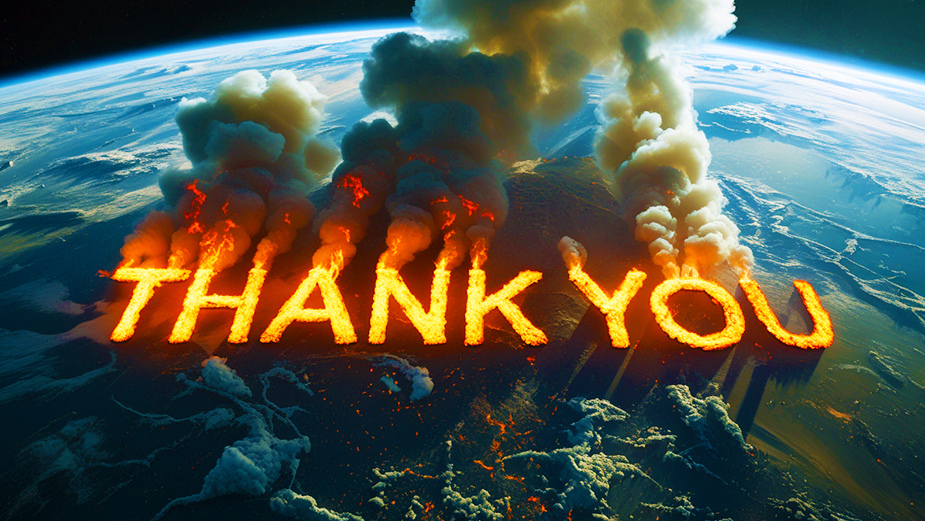
Manners Cost Nothing – Apart from the Earth and Advertising Itself

“It’s nice to be important, but it’s important to be nice.” That old nugget of wisdom has lived on our agency corkboard for years (cited courtesy of our marketing director’s nan). It’s a warm reminder that courtesy and tone matters in communication, be it in a client call or in your next campaign headline.
But courtesy now comes at a cost: an energy cost. We recently read* that being polite to your AI chatbot could be burning through more computational juice than just direct prompting. This means, allegedly, that every ‘please’ and ‘thank you’ going through the LLM is inadvertently inflating carbon emissions. Suddenly, our friendly prompt etiquette isn't just overkill, it’s eco-unfriendly.
So where does that leave us? If we’re being nudged toward short, sharp AI interactions for the sake of sustainability, does that shift bleed out into how we communicate more broadly and, for our industry, especially within advertising?
We’re already operating in a landscape where algorithms have outmuscled audiences as the first line of judgment. Ad content follows this trend, tiptoeing around machine preferences with SEO, engagement metrics, and platform quirks, before a human even lays eyes on it. So where does that leave the wit and charm elements we take pride in? It feels it’s too often pruned down to fit the favoured format of the algorithmic overlords.
In our own dabbling with AI tools, we approached interaction akin to treating them like teammates. We built rapport, we riffed in pirate puns. We collaborated back and forth as if conversing with a colleague: warmly and sprinkled with banter. But now we wonder. In trying to humanise our interaction with the machine, were we just generating more waste? Were we undermining our carbon policy with our well-mannered verbosity?
It’s a provocative thought, and one with real implications for how we craft advertising communication. If AI, acting both as a tool and a gatekeeper, is nudging us toward blunt efficiency, does this mean the art of the brand voice is being stripped back too?
We already see this in the sameness of modern UX design and website copy which generally feels functional, optimised, but often flat. We see it in headlines pared down to keyword-rich soundbites. Design variation diluted to appease Google algorithms over audience, and more recently content and structure adapted for chatbots over customers. Marketing has always walked a line between clarity and character, but the pressure to ‘speak AI’ threatens to tip that balance.
Even generational shifts are reinforcing the trend. Gen z are said to prefer directness, even brusqueness, over the polite fluff of older generations. In brand comms, this can work, but only when it’s authentic. If brands all try to sound gen z, or ‘machine-compatible’, we risk a rinse-repeat tone that makes everything sound like a bot wrote it.
So what happens when copy gets reduced to the fewest characters, the most indexable phrasing, the least emotional friction?
We could see:
- ‘U buy b4 2 l8’ (noughties text speak renaissance);
- Binary-coded brand statements (to cut out the human completely);
- Hashtag-ready, algorithmically pleasing campaigns that have all the soul of a toaster.
That’s not what we got into advertising for. Or at least, not what we stay for.
And yet, here we are. The question isn’t whether AI will change how we speak to each other and to audiences. It already has. The better question is: how do we keep human tone, story and persuasion alive in a world where AI is the middleman?
Maybe it’s time we stop designing solely for the machine and instead demand the platforms meet us halfway. If a high-performing post tanks overnight, ask the platform why. If a chatbot refuses to play nice with your brand tone, give feedback. And if your campaign has to compromise tone for SEO, push back.
We’re marketers. Communicators. Brand-builders. And whether we’re talking to a consumer, a client, or an algorithm, tone still matters. Manners – that instinct for nuance, empathy, and human connection – is part of what makes great advertising work.
So yes, we’ll keep saying ‘please’ and ‘thank you’. Even to the bots. Because in advertising, how we say something is often just as important as what we say. And if that means giving a little extra compute to save a little extra soul, I say it’s worth the watts.
After all, manners maketh the man, woman, person… human
And humans make the brand.















